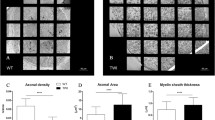Summary
A teased fibre and electron-microscopical study was carried out on the sciatic nerves of mice affected with the peripheral neuropathy in dystonia musculorum. Widespread segmental demyelination was present in all the nerves. Focal axon swellings were also seen, but were relatively scarce and similar in appearance to post-traumatic reactive swellings. The variability of dystonic internodal lengths was indicative of segmental demyelination rather than axonal degeneration. The largely motor fibres of the phrenic nerve were seen to undergo a similar degenerative process, but with a later onset and more gradual progression. Segmental demyelination was found to be present before axon swellings and other degenerative changes became visible in developing phrenic nerve. Demyelination is thus an important pathological process in dystonia musculorum, and the present observations are consistent with a primary segmental demyelinating disorder in dystonic peripheral nerve.
Similar content being viewed by others
References
Allt G (1969) Repair of segmental demyelination in peripheral nerves. An electron microscope study. Brain 92:639–646
Asbury AK (1967) Schwann cell proliferation in developing mouse sciatic nerve. J Cell Biol 34:735–743
Biscoe TJ, Lawson SN, Makepeace APW, Stirling CA (1978) Apparatus for the measurement of micrographs and other experimental records. J Physiol 277 5–6P
Duchen LW, Strich SJ, Falconer DS (1964) Clinical and pathological studies of an hereditary neuropathy in mice (Dystonia Musculorum). Brain 87:367–378
Dyck PJ (1975) Pathological alterations of the peripheral nervous system in man. In: Dyck PJ, Thomas PK, Lambert EM (eds) Peripheral neuropathy [Ch. 15]. Saunders and Co., Philadelphia, pp 296–336
Dyck PJ, Gomez MR (1968) Segmental demyelination in Dejerine-Sottas disease — light phase contrast and electron microscope studies. Mayo Clin Proc 43:280–296
Dyck PJ, Johnson WJ, Lambert EM, O'Brien PC (1971) Segmental demyelination secondary to axonal degeneration in uremic neuropathy. Mayo Clin Proc 46:401–431
Fullerton PM, Gilliat RW, Lascelles RE, Morgan-Hughes JA (1965) The relation between fibre diameter and internodal length in chronic neuropathy. J Physiol. 178:26–28P
Gill PK, Kuno M (1963) Excitatory and inhibitory actions of phrenic motorneurones. J Physiol 168:274–289
Hanker JS, Peach R (1976) Histochemical and ultrastructural studies of primary sensory neurones in mice with Dystonia Musculorum. Neuropath Appl Neurobiol 2:79–97
Hinsey JC, Hare K, Phillips RA (1939) Sensory component of the phrenic nerve of cat. Proc Soc Exp Biol NY 47:111–414
Hopkins A (1970) The effect of acrylamide on the peripheral nervous system of the baboon. J Neurol Neurosurg Psychiat 33:805–816
Janota I (1972) Ultrastructural studies of a hereditary sensory neuropathy in mice (Dystonia Musculorum). Brain 95:529–536
Lampert P (1967) A comparative electron-microscopic study of reactive, degenerating, regenerating, and dystrophic axons. J Neuropath Exp Neurol 26:345–368
Lampert PW, Schochet SS (1968) Demyelination and remyelination in lead neuropathy. Electron-microscopic studies. J Neuropath Exp Neurol 27:527–545
Lubińska L (1961) Demyelination and remyelination in the proximal parts of regenerated nerve fibres. J Comp Neurol 117:275–289
Madrid RC, Wisniewski HM (1977) Axonal degeneration in demyelinating disorders. J Neurocytol 6:103–117
Messer A, Strominger LM (1980) An allele of the mouse mutant dystonia musculorum exhibits lesions in red nucleus and striatum. Neuroscience 5:543–549
Moss TH (1980) Observations on teased axons in the dystonic mutant mouse. J Physiol 200:22P
Schröder JM (1975) Degeneration and regeneration of myelinated nerve fibres in experimental neuropathies. In: Dyck PJ, Thomas PK, Lambert EM (eds) Peripheral neuropathy [Ch. 16]. Saunders and Co., Philadelphia, pp 337–362
Thornburg LP, Hanker JS (1975 Lysosomal hydrolases in the trigeminal ganglion of mice affected with a hereditory sensory neuropathy (Dystonia Musculorum). Acta Neuropathol 32: 91–101
Weller RD, Nester B (1972) Early changes at the nodes of Ranvier in segmental demyelination; histochemical and electron-microscopic observations. Brain 95:665–674
Author information
Authors and Affiliations
Rights and permissions
About this article
Cite this article
Moss, T.H. Segmental demyelination in the peripheral nerves of mice affected by a hereditary neuropathy (dystonia musculorum). Acta Neuropathol 53, 51–56 (1981). https://doi.org/10.1007/BF00697184
Received:
Accepted:
Issue Date:
DOI: https://doi.org/10.1007/BF00697184



